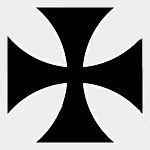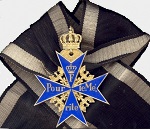Wings of the Great War WW12004 German Fokker Dr.I Triplane Fighter - Lt. Werner Voss, Jasta 10, 1917 (1:72 Scale)
"The important thing in aeroplanes is that they shall be speedy."
- Baron Manfred Von Richthofen
 The Fokker Dr.I Dreidecker (triplane) was a World War I fighter aircraft built by the company of Anthony Fokker, and designed by Reinhold Platz. It became most famous as the plane of the Red Baron, Manfred von Richthofen.
The Fokker Dr.I Dreidecker (triplane) was a World War I fighter aircraft built by the company of Anthony Fokker, and designed by Reinhold Platz. It became most famous as the plane of the Red Baron, Manfred von Richthofen.
In April 1917, the Royal Naval Air Service (RNAS) introduced the Sopwith Triplane. Their debut was sensational and they swiftly proved to be superior to the Albatros and Halberstadt scouts then in use by the German Air Service. Soon the German pilots were clamouring for a triplane of their own. The majority of the German aircraft manufacturers, including Pfalz, AEG, DFW, Schütte-Lanz, and Euler, responded with new triplane designs. Most displayed little promise, though limited production of the Pfalz Dr. I was undertaken.
Fokker responded with the V.3, a small rotary-powered triplane with a tubular steel frame fuselage and thick cantilever wings. Fokker found several deficiencies in the V.3, particularly regarding control forces. Instead of submitting the V.3 for a type test, Fokker produced a revised prototype designated V.4. The most notable changes were horn-balanced ailerons and elevators, as well as wings of increased span. The V.4 also featured interplane struts, which were not necessary from a structural standpoint, but which had the effect of minimizing wing flexing. The V.4 proved highly manueverable and much superior to the triplane prototypes submitted by other manufacturers. The rudder and elevator controls were powerful and light. Rapid turns were facilitated by the triplane's directional instability. The ailerons were also light, but not very effective.
After a type test, an immediate production order ensued. The V.4 prototype was intentionally destroyed in static structural tests. The two pre-production examples, designated F.I, were delivered in the middle of August 1917. These were the only machines to receive the F.I designation. Delivery of production machines, designated Dr.I, commenced in October of that year.
Pictured here is a 1:72 scale replica of a German Fokker Dr.1 triplane fighter piloted by Lt. Werner Voss, who was attached to Jasta 10 during 1917.
Sold Out!
Dimensions:
Length: 4-inches
Wingspan: 5-inches
Release Date: November 2018
 Historical Account: "The Bravest German Airman" - Werner Voss (April 13th, 1897 - September 23rd, 1917) was a World War I German flying ace credited with 48 aerial victories.
Historical Account: "The Bravest German Airman" - Werner Voss (April 13th, 1897 - September 23rd, 1917) was a World War I German flying ace credited with 48 aerial victories.
Voss, a dyer's son from Krefeld, was a patriotic young man even while still in school. He began his military career in November 1914 as a 17-year‑old Hussar. After turning to aviation, he proved to be a natural pilot. After flight school and six months in a bomber unit, he joined a newly formed fighter squadron, Jagdstaffel 2 on November 21st, 1916. There he became friends with Manfred von Richthofen.
By April 6th, 1917, Voss had scored 24 victories and awarded Germany's highest award, the Pour le Merite. The medal's mandatory month's leave removed Voss from the battlefield during Bloody April; in his absence, Richthofen scored 13 victories. Nevertheless, Richthofen regarded Voss as his only possible rival as top scoring ace of the war.
Soon after Voss returned from leave, he was at odds with his squadron commander. He was detailed from his squadron to evaluate new fighter aircraft and became enthusiastic about the Fokker Triplane. After transferring through three temporary squadron commands in two months, Voss was given command of Jagdstaffel 10 on July 30th, 1917 at Richthofen's request. By now, his victory total was 34.
His last stand came on September 23rd, 1917, just hours after his 48th victory. After he fell in solo opposition to eight British aces, he was described by his preeminent foe, James McCudden, as "the bravest German airman".


